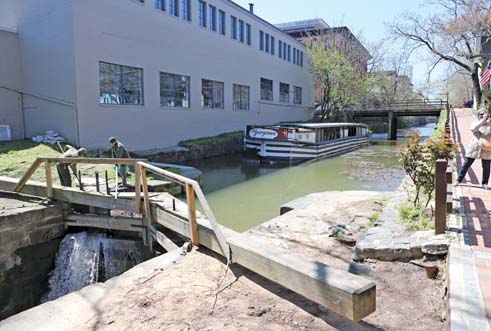C&O Canal Lock Due for Disruptive Repair

By Brady HoltCurrent Staff Writer
An 18-month rehabilitation of the C&O Canal’s Lock 3 will begin this fall, requiring the D.C. stretch of canal to be drained for the duration of the work and blocking off canal access between 30th and Thomas Jefferson streets NW.
The canal’s system of locks isn’t currently in use in Georgetown, as the replica canal boat that traversed it stopped operating several years ago. But the Georgetown Heritage nonprofit, an arm of the neighborhood’s business improvement district, ultimately hopes to resume that tourist attraction.
The National Park Service concluded last summer that Lock 3 needed a $5.5 million investment before those boat trips can take place, and that Lock 4, a block away, also needed $1 million in repairs. The agency now has funding for the Lock 3 work, C&O Canal National Historical Park superintendent Kevin Brandt said at Monday’s meeting of Advisory Neighborhood Commission 2E (Georgetown, Burleith).
“When we took that [boat] out of service, we knew we had some problems with the locks the boat typically passes through,” Brandt said at the meeting. “In the intervening years, the lock has continued to deteriorate at a very rapid rate.”
At Lock 3, the Park Service will carefully deconstruct the original 1830s lock, store the salvageable materials on the open lawn the agency owns adjacent to the canal, and then meticulously rebuild it to its original form. An exception is that wood framing, not visible from the outside, appears to have deteriorated and will be replaced with concrete, Brandt said. The agency has already done similar reconstruction efforts at a half-dozen C&O Canal locks over the years.
The Park Service hopes to begin the Lock 3 project in October and finish it by April 2018. Brandt said the agency will need to drain the canal east of Lock 5, located just over the Maryland line, to safely carry out the work. He said he’s working with the Georgetown Business Improvement District on temporary beautification efforts to offset the effect of the drained canal, such as planting wildflowers on portions of the canal bed.
To accommodate construction, sidewalks and the towpath will be closed on the block where the work is taking place, the bust of Supreme Court Justice William O. Douglas will be temporarily relocated, and the tree above the bust will be removed.
Meanwhile, repairs to Lock 4 aren’t yet funded, Brandt said, and he didn’t yet have a timeline for the work. But because that lock is in better shape, the project will be less intrusive — requiring only improved grout and rebuilt curved walls — and won’t completely block off access to that area.
Community members at Monday’s meeting noted that some businesses’ main entrances are accessed from the canal near Lock 4; Brandt said customers will still be able to get through despite some disruptions. He also said the project will reduce the leaks that have plagued residents living along the canal.
Once the work at the two locks is complete, the canal will again be navigable for the new replica boat that organizers are planning. “When Georgetown Heritage is able to have a boat back on the canal, it’s going to be able to go through these locks very safely,” Brandt said.
He also noted that major reconstruction of Lock 3 involves an unusual scale of disruption.
“To my knowledge, it’s never been done, so it’s lasted from the 1830s until 2016,” Brandt said. “So in our lifetimes it should never need to be done again.”
The Old Georgetown Board will consider the plans for the two locks at its monthly meeting tomorrow. ANC 2E unanimously voted to raise no objection to the proposal, and commissioners noted that restoring the canal has been among their top priorities in recent years. “The careful work done by the Park Service on this and many other projects is very much appreciated,” commission chair Ron Lewis said.
Commissioners did emphasize that their support for these rehabilitation projects does not extend to future proposals to activate the C&O Canal in Georgetown, which it will consider once specific proposals come before ANC 2E. Brandt said that this summer, stakeholders likely will begin a yearlong master planning process for the canal area, but this particular project will only restore the locks to their original forms.
This article appears in the April 6 issue of The Georgetown Current newspaper.
